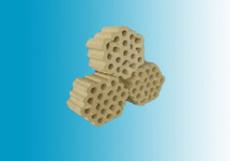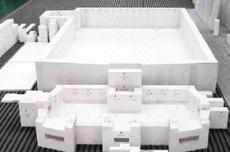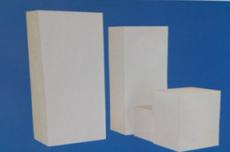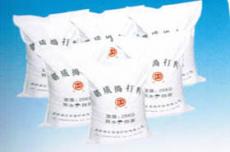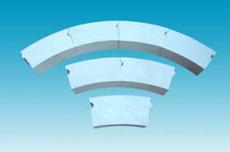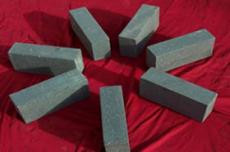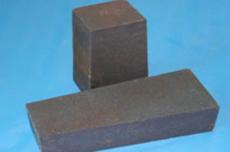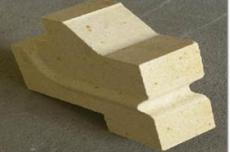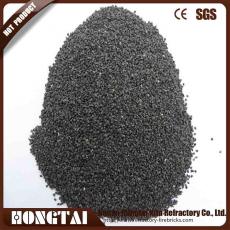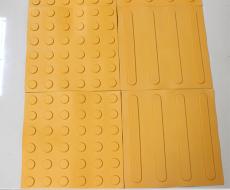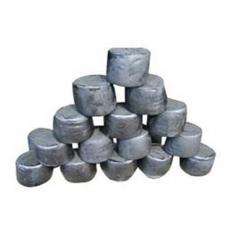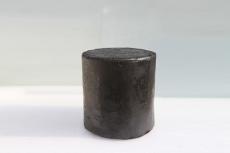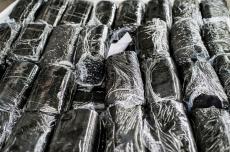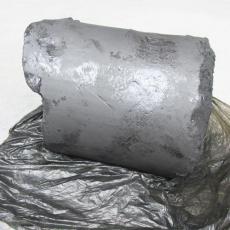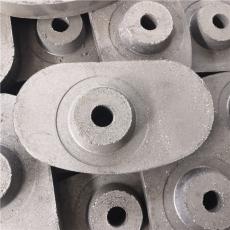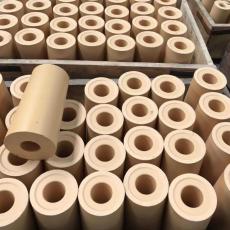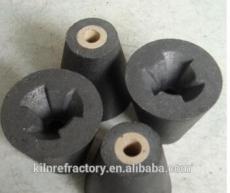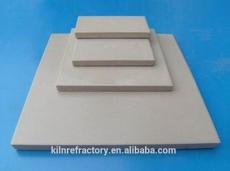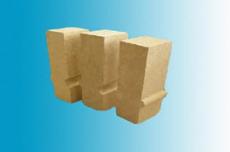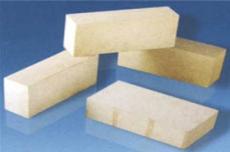
The coke oven is a continuous working thermal equipment that heats coal to 950-1100℃ under air-tight conditions and obtains coke and its by-products through dry distillation.
The coke oven is mainly composed of a combustion chamber, a carbonization chamber, a furnace top, a ramp, a heat storage chamber and a small flue.
(1) Carbonization chamber and heat storage chamber. In addition to bearing the weight of coal and coke, the bottom of the coke oven carbonization chamber is also subject to friction during the coke pushing process. The top of the carbonization chamber is subject to the static and dynamic loads of the upper covering layer and the stoker. Therefore, refractory bricks with high strength and wear resistance should be selected.
During the coking process, water is discharged at the low temperature stage, and the combustion products of the gas contain a small amount of water. Therefore, it is not suitable to use hydrating refractory bricks in the carbonization chamber and the combustion chamber.
The carbonization chamber and regenerator of the coke oven work periodically. The actual temperature of the carbonization chamber wall surface is 1000-1100℃. After the coke is discharged, the temperature of the refractory brick masonry gradually decreases, and drops to about 700℃ after the cold coal is loaded. According to this feature, the carbonization chamber is built with silica bricks. Silica bricks have high high-temperature strength, and the load softening temperature is close to the refractoriness (generally 1620~1660℃, and high-quality silica bricks are greater than 1660℃). They have the advantage of not deforming under long-term use at high temperatures. Well-fired silica bricks generally have no crystal transformation above 600℃, and the temperature expansion coefficient is also small. However, due to the large temperature difference between hot and cold alternations on both sides of the regenerator, high-quality clay refractory bricks should be used. Sometimes, in order to ensure the overall structure of the entire coke oven and avoid using materials with different linear expansion coefficients, siliceous materials are still used, and clay bricks are used to protect them on the outside. The checker bricks in the heat storage chamber are non-load-bearing structures and should be made of clay refractory bricks.
The lining of the carbonization chamber door and the furnace heads at both ends of the carbonization chamber, due to the sudden change in temperature when the furnace door is opened, from 1000℃ to below 500℃, exceeds the volume stability limit of silica bricks (573℃), so materials with better thermal shock resistance are selected. In the past, clay refractory bricks were mostly used, but now they tend to use high-quality high-aluminum materials (Al2O3 less than 60%) that are resistant to thermal shock, such as andalusite bricks, high-aluminum bricks, etc.
(2) Combustion chamber and inclined flue. Silica bricks are used in the combustion chamber. Except that the inclined flue area does not directly contact coal and coke, other working conditions are similar to those of the carbonization chamber combustion chamber, but the maximum working temperature is slightly lower than that of the combustion chamber. In order to ensure the overall structure of the coke oven, silica bricks are still used in this area.
In general, the refractory bricks used in coke ovens are mainly silica refractory bricks. The phase composition of silica bricks should be mainly quartz, and the less residual quartz, the better. According to statistics, the content should be less than the impurities such as Al2O3·Fe2O3 and alkaline oxides in the chemical composition, and should be reduced to the allowable range. Because these impurities have a great influence on the performance of silica bricks, such as reducing the load softening temperature and increasing the melting index.
1. Silica Bricks
Silica bricks are acidic refractory materials with good resistance to acid erosion. They have good thermal conductivity and high load softening temperature, generally above 1620℃, which is only 70~80℃ lower than their refractoriness. The thermal conductivity of silica bricks increases with the increase of working temperature, and there is no residual shrinkage. During the baking process, the volume of silica bricks increases with the increase of temperature. Therefore, silica bricks are ideal refractory products for coke ovens. Important parts of modern large and medium-sized coke ovens (such as combustion chambers, ramps and regenerators) are built with silica bricks.
During the baking process, the maximum expansion of silica bricks occurs between 100~300℃, and the expansion before 300℃ is about 70%~75% of the total expansion. The reason is that SiO2 has four crystal transformation points at 117℃, 163℃, 180~270℃ and 573℃ during the baking process. Among them, the volume expansion caused by cristobalite is the largest between 180~270℃. The key to determining the thermal stability of silica bricks is true density, and the size of true density is one of the important signs to determine its quartz transformation. The smaller the true density of silica bricks, the more complete its lime transformation, and the smaller the residual expansion generated during the baking process. Among silica bricks, tridymite crystals have the smallest true density, small linear expansion rate, better thermal stability than cristobalite and quartz, strong resistance to slag erosion, good thermal conductivity, high load softening temperature, and are the most stable form of quartz. In silica bricks with good firing, tridymite has the highest content, accounting for 50%~80%; cristobalite is second, accounting for only 10%~30%; and the content of quartz and glass phase fluctuates between 5%~15%. When the working temperature is lower than 600~700℃, the volume of silica bricks changes greatly, the resistance to rapid cooling and heating is poor, and the thermal stability is not good. If the coke oven works at this temperature for a long time, the masonry will easily crack and break.
2. Clay bricks
Clay bricks refer to clay products with an Al2O3 content of 30%~40% aluminum silicate materials. Clay bricks are made of 50% soft clay and 50% hard clay clinker, which are mixed according to certain particle size requirements. After molding and drying, they are fired at a high temperature of 1300~1400℃. The mineral composition of clay bricks is mainly kaolinite (Al2O3·2SiO2·2H2O) and 6%~7% impurities (potassium, sodium, calcium, titanium, and iron oxides). The firing process of clay bricks is mainly the process of kaolinite continuously losing water and decomposing to form mullite (3Al2O3·2SiO2) crystals.
During the firing process, SiO2 and Al2O3 in clay bricks form eutectic low-melting silicates with impurities, which surround mullite crystals. Clay bricks are weakly acidic refractory products that can resist the erosion of acidic slag and acidic gases, but have a slightly poor resistance to alkaline substances. Clay bricks have good thermal properties and are resistant to rapid cooling and heating. The refractoriness of clay bricks is comparable to that of silica bricks, up to 1690~1730℃, but the load softening temperature is more than 200℃ lower than that of silica bricks. Because clay bricks contain nearly half of the low-melting amorphous glass phase in addition to highly refractory mullite crystals. In the temperature range of 0~1000℃, the volume of clay bricks expands evenly with the increase of temperature, and the linear expansion curve is close to a straight line, with a linear expansion rate of 0.6%~0.7%, which is only about half of that of silica bricks. When the temperature reaches 1200℃ and continues to rise, its volume will begin to shrink from the maximum expansion value. The residual shrinkage of clay bricks leads to cracking of masonry mortar joints, which is a major disadvantage of clay bricks. When the temperature exceeds 1200℃, the low melting point substances in clay bricks gradually melt, and the particles are close to each other due to surface tension, resulting in volume shrinkage.
Due to the low load softening temperature of clay bricks, shrinkage occurs at high temperatures, and the thermal conductivity is 15%~20% lower than that of silica bricks, and the mechanical strength is also worse than that of silica bricks. Therefore, clay bricks can only be used in secondary parts of coke ovens, such as heat storage chamber sealing walls, small flue lining bricks and heat storage chamber lattice bricks, furnace door lining bricks, furnace roof and riser lining bricks.
3. High Alumina Bricks
High alumina bricks are refractory products made of aluminum silicate or alumina with an Al2O3 content greater than 48%, collectively referred to as high alumina refractory products. High alumina bricks have higher refractoriness and load softening temperature than clay bricks, and have better slag corrosion resistance (especially for acidic slag), and these properties increase with the increase of Al2O3 content, but the thermal stability is not as good as clay bricks. High alumina bricks have high density, low porosity, high mechanical strength and wear resistance. The furnace head of the coke oven combustion chamber and the furnace head of the carbonization chamber are built with high alumina bricks, and the effect is better; but it is not suitable for the wall of the carbonization chamber, because high alumina bricks are prone to curling and warping at high temperatures.
Refractory mud
Refractory mud is an amorphous refractory material composed of powdered materials and binders for preparing mud. It is mainly used as a binder and coating material for masonry of refractory bricks. Refractory mud is mostly used to make mud by adding water (or aqueous solution). It should have the corresponding properties of masonry bricks. Refractory mud for coke ovens should meet the following requirements:
(1) It should have the necessary adhesion after construction and during use to ensure that it is bonded to the masonry or surrounding layers as a whole, so that it should have the function of resisting external forces and gas and slag erosion.
(2) It must have good fluidity and plasticity to facilitate construction.
(3) It should have the same chemical composition as the masonry or surrounding layer material to avoid the refractory mud from being destroyed first and to avoid adverse chemical reactions between different materials.
(4) It should have the same thermal expansion as the masonry or surrounding layer material to avoid separation and cracking of the mud layer.
(5) The volume should be stable and have a small shrinkage to ensure the integrity and tightness of the masonry.
(6) It can be sintered at the use temperature to increase the mechanical strength of the masonry.
(7) It should have a certain refractoriness and load softening point.
The corresponding refractory mud should be selected according to the brick type and operating temperature, that is, clay fire mud should be used for clay bricks and silica fire mud should be used for silica bricks.
With the increasing demand for coke in the steel industry, coke ovens are developing towards larger volumes. Large coke ovens place higher demands on refractory materials. Currently, coke oven silica bricks are continuously developing towards higher strength, higher density and higher thermal conductivity.
